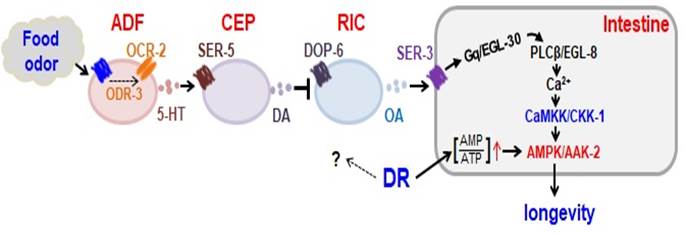On March 15, 2021, one research article, named ‘Olfactory perception of food abundance regulates dietary restriction-mediated longevity via a brain-to-gut signal’, from professor Jianfeng Liu lab in College of Life Science and Technology, Huazhong University of Science and Technology was published on Nature Aging journal. And in the same issue, one News & Views report from professor Michael N. Nitabach in Yale University (USA), named ‘Food odors decrease longevity via a brain–gut axis’, was published to positively introduce and evaluate this study. In brief, this study illustrates one novel regulatory pathway for olfactory perception of food to regulate dietary restriction-mediated longevity, which would provide new targets for anti-aging research and drug development.
Previous studies performed in diverse organisms, including human-beings, have confirmed that dietary restriction (DR) is almost the most conserved and effective intervention to slow down aging and promote longevity. For the past decades, the regulatory mechanisms of nutrient components in food, like protein, lipid, carbohydrate, in aging and longevity regulation by DR were extensively investigated and a number of achievements were presented. However, quite little is known about how the non-nutrient components from food source, like odors, and nonvolatile, non-nutrient chemicals, would regulate DR induced longevity.
In this study, C.elegans, one classic model system in aging research, was used to comprehensively investigate the regulatory roles of food odors and olfactory perception of food in DR induced longevity. Surprisingly, the researchers found that odors released from food source could decrease the DR induced lifespan extension by 50%, while would not change the longevity of worms fed on ad libitum (AL) condition. Further, they identified one novel ‘brain-gut’ axis that transmits the signals from food odors to suppression of classic nutrient sensor AMPK activity in C.elegans intestine, thus leading to the inhibition of DR induced longevity: under DR, food odors would activate serotonergic ADF neurons, and then stimulate the activity of dopaminergic CEP neurons via serotonergic GPCR SER-5, which would inhibit the octopamine release from RIC neurons via dopaminergic GPCR DOP-6; less octopamine received by the downstream putative octopaminergic GPCR SER-3 would cause lower activity of EGL-30/EGL-8/CKK-1 signaling cascade, which could reduce the phosphorylation level and activity of AAK-2/AMPK in C.elegans intestine, ultimately leading to the inhibition of DR mediated lifespan extension. Moreover, intestinal AMPK and the olfactory neuron circuit for perception of food are determined as the two critical ‘hubs’ to integrate the odor signals and nutrient values from food source for DR mediated longevity: intestinal AMPK is not only negatively regulated by food odors via a brain-gut signal but also could be allosterically activated by AMP, the level of which would greatly increase under DR; while, the activity of olfactory neuron circuits for perception of food not only stimulated by food odors but also modulated by the internal energy level (AMP/ATP ratio). More importantly, the further experiments performed with primary adipocytes and hepatocytes clearly demonstrated that α-1A adrenoceptor, the homolog of SER-3 in mammalian cells, and the downstream Gq/PLCβ/CaMKK signaling cascade could regulate AMPK activity in a similar manner as in C.elegans intestine, which indicates that this pathway in highly conserved, and would providing novel potential targets for anti-aging research.

Figure 1: olfactory neuron circuit for perception of food odors and the downstream signaling pathways regulate dietary restriction-mediated longevity.
Professor Jianfeng Liu from College of Life Science and Technology in Huazhong University of Science and Technology (HUST) and Professor Shawn Xu from Life Sciences Institute in University of Michigan are the corresponding authors. Postdoc Bi Zhang from Liu lab in HUST is the first author. Heejin Jun (Ph.D) and professor Jun Wu from Life Sciences Institute in University of Michigan are co-authors. This study was supported by grants from NSFC and National Key Research and Development Program from Ministry of Science and Technology.